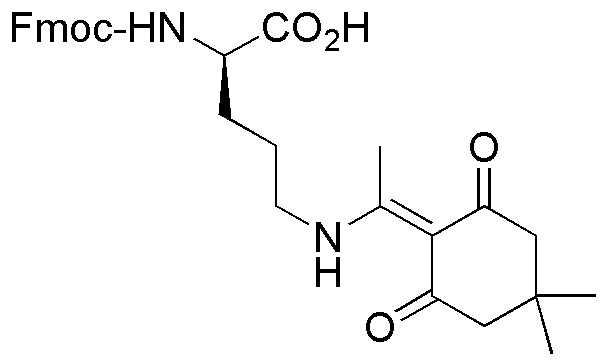Na-Fmoc-Nd-1-(4,4-dimethyl-2,6-dioxocyclohex-1-ylidene)ethyl-D-Ornithine is widely utilized in research focused on:
- Peptide Synthesis: This compound serves as a protective group in the synthesis of peptides, allowing for selective reactions that enhance the efficiency of creating complex molecules.
- Drug Development: It plays a crucial role in the pharmaceutical industry for developing new drugs, particularly in designing compounds that target specific biological pathways.
- Bioconjugation: The chemical is used in bioconjugation processes, linking biomolecules to enhance their stability and efficacy, which is essential in creating targeted therapies.
- Research in Cancer Therapy: It is being investigated for its potential applications in cancer treatment, where modifying peptide structures can lead to more effective therapeutic agents.
- Material Science: The compound is also explored in material science for creating novel materials with specific properties, such as improved biocompatibility for medical devices.
General Information
Properties
Safety and Regulations
Applications
Na-Fmoc-Nd-1-(4,4-dimethyl-2,6-dioxocyclohex-1-ylidene)ethyl-D-Ornithine is widely utilized in research focused on:
- Peptide Synthesis: This compound serves as a protective group in the synthesis of peptides, allowing for selective reactions that enhance the efficiency of creating complex molecules.
- Drug Development: It plays a crucial role in the pharmaceutical industry for developing new drugs, particularly in designing compounds that target specific biological pathways.
- Bioconjugation: The chemical is used in bioconjugation processes, linking biomolecules to enhance their stability and efficacy, which is essential in creating targeted therapies.
- Research in Cancer Therapy: It is being investigated for its potential applications in cancer treatment, where modifying peptide structures can lead to more effective therapeutic agents.
- Material Science: The compound is also explored in material science for creating novel materials with specific properties, such as improved biocompatibility for medical devices.
Documents
Safety Data Sheets (SDS)
The SDS provides comprehensive safety information on handling, storage, and disposal of the product.
Product Specification (PS)
The PS provides a comprehensive breakdown of the product’s properties, including chemical composition, physical state, purity, and storage requirements. It also details acceptable quality ranges and the product's intended applications.
Certificates of Analysis (COA)
Search for Certificates of Analysis (COA) by entering the products Lot Number. Lot and Batch Numbers can be found on a product’s label following the words ‘Lot’ or ‘Batch’.
*Catalog Number
*Lot Number
Certificates Of Origin (COO)
This COO confirms the country where the product was manufactured, and also details the materials and components used in it and whether it is derived from natural, synthetic, or other specific sources. This certificate may be required for customs, trade, and regulatory compliance.
*Catalog Number
*Lot Number
Safety Data Sheets (SDS)
The SDS provides comprehensive safety information on handling, storage, and disposal of the product.
DownloadProduct Specification (PS)
The PS provides a comprehensive breakdown of the product’s properties, including chemical composition, physical state, purity, and storage requirements. It also details acceptable quality ranges and the product's intended applications.
DownloadCertificates of Analysis (COA)
Search for Certificates of Analysis (COA) by entering the products Lot Number. Lot and Batch Numbers can be found on a product’s label following the words ‘Lot’ or ‘Batch’.
*Catalog Number
*Lot Number
Certificates Of Origin (COO)
This COO confirms the country where the product was manufactured, and also details the materials and components used in it and whether it is derived from natural, synthetic, or other specific sources. This certificate may be required for customs, trade, and regulatory compliance.


